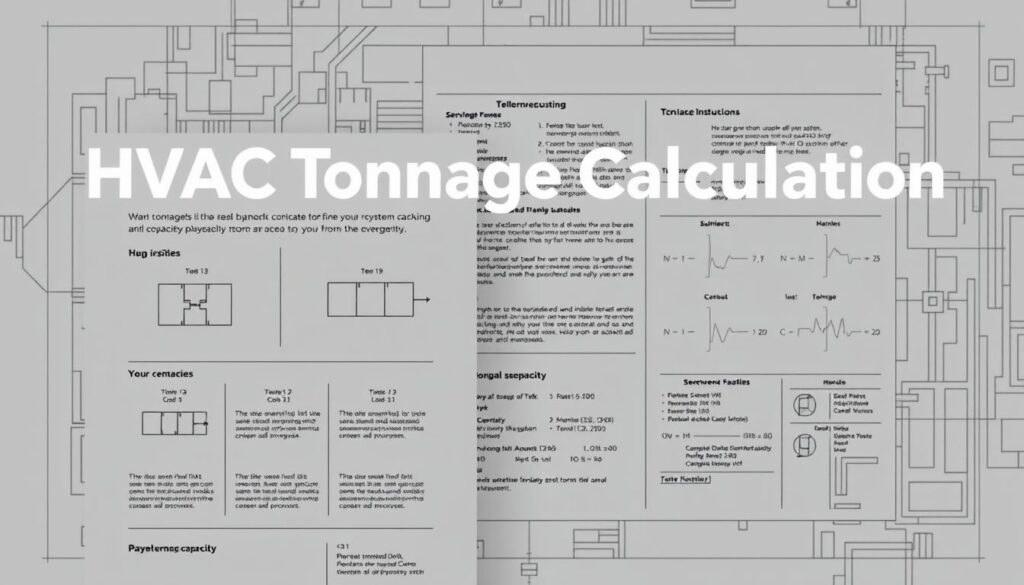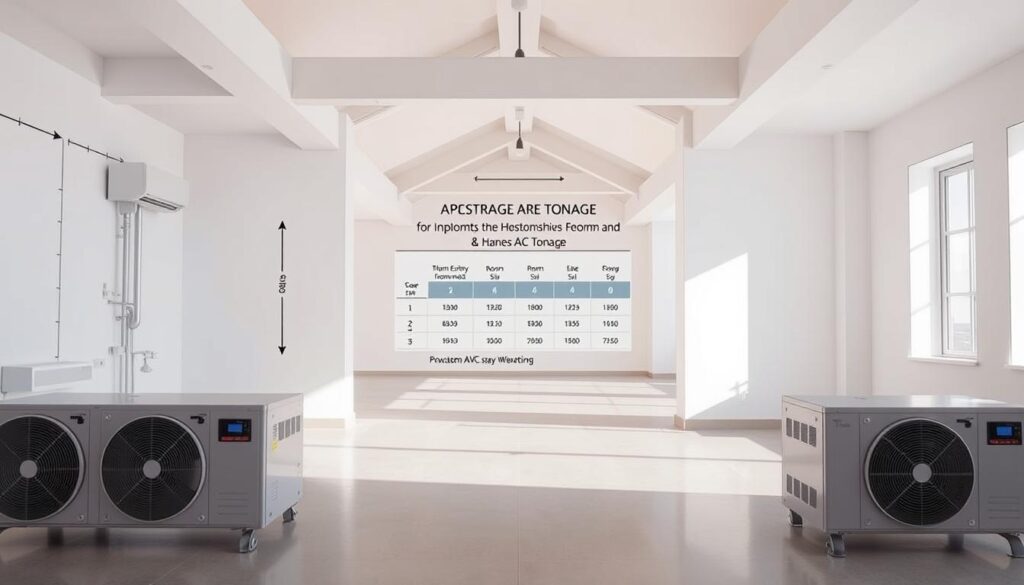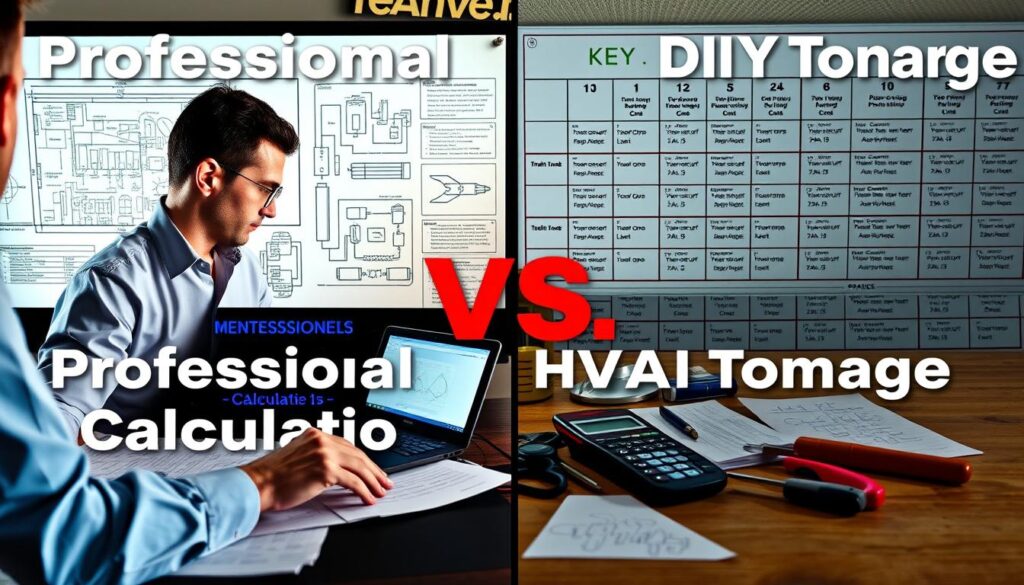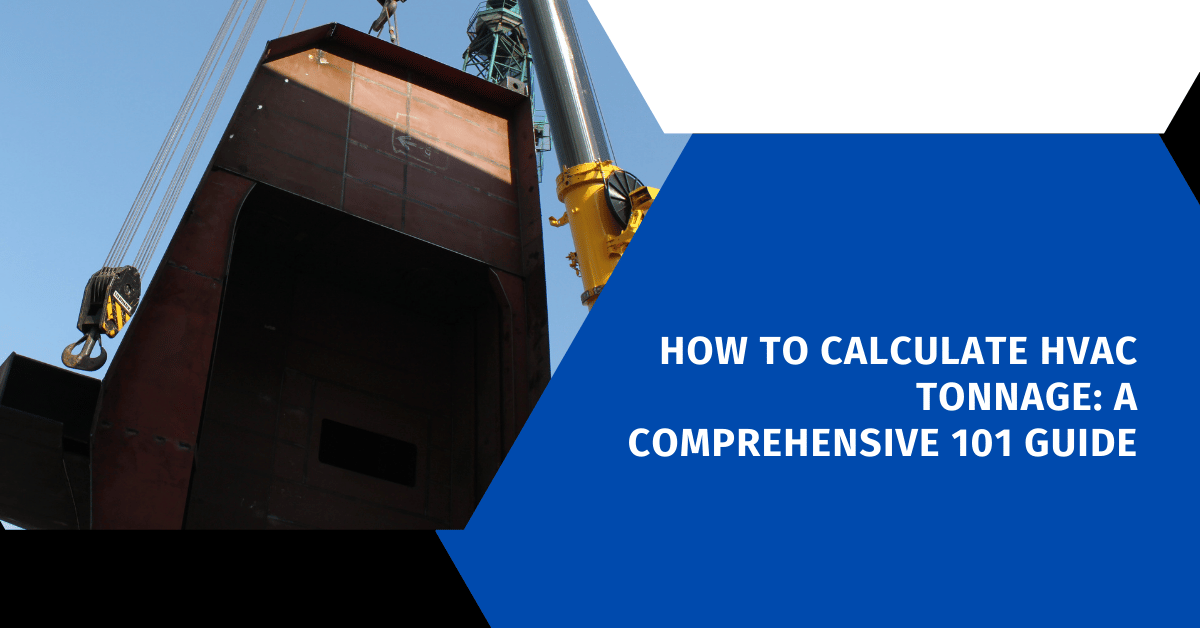Affiliate Disclosure
HVAC Guide Guys is a participant in the Amazon Services LLC Associates Program, an affiliate advertising program designed to provide a means for sites to earn advertising fees by advertising and linking to Amazon.
How to Calculate HVAC Tonnage? Ever wondered how experts pick the right cooling for your place? Knowing how to figure out HVAC tonnage is key for comfy and green spaces.

Choosing the right air conditioner isn’t random. It’s a science that affects your comfort, energy costs, and HVAC health. The correct size keeps your space cool without wasting energy or overworking your system.
In this detailed guide, we’ll cover all you need to know about HVAC tonnage. You’ll learn from basic to advanced methods. This will help you make smart choices for your cooling systems.
Key Takeaways
- HVAC tonnage shows cooling power in 12,000 BTU chunks
- Getting the tonnage right stops system waste
- Many things affect the right HVAC size
- Getting a pro’s opinion boosts long-term performance
- Choosing the right tonnage saves energy
Table of Contents
Understanding HVAC Tonnage Basics
Knowing about HVAC tonnage is key to keeping your home or office cool. HVAC experts use special measurements to find the perfect cooling size for each space. This ensures your place stays comfy and uses less energy.
The term “cooling capacity calculation” is more than just jargon. It’s the secret to picking the right air conditioner. HVAC tonnage might seem complicated, but it’s easy once you get it.
Definition of HVAC Tonnage
One ton of cooling power means an air conditioner can take out 12,000 BTUs of heat in an hour. This is the btu to ton conversion that shows how much cooling you need.
- 1 ton = 12,000 BTUs per hour
- Cooling capacity determines system efficiency
- Precise measurements ensure optimal comfort
Why Tonnage Matters in HVAC Systems
Choosing the right HVAC tonnage is vital for keeping temperatures steady and saving energy. A system that’s too small can’t cool well, while one that’s too big wastes energy and cools unevenly.
The Relationship Between BTUs and Tons
Knowing how BTUs and tons relate helps you decide on your cooling needs. Cooling capacity calculation involves looking at your space’s size, insulation, and climate. This helps find the perfect fit.
Proper HVAC tonnage selection can reduce energy costs by up to 30%.
How to Calculate HVAC Tonnage
Calculating HVAC tonnage is key for good heating and cooling in your space. The hvac sizing formula has several steps to find the right cooling capacity for your home or building.
To figure out HVAC tonnage, you need to look at a few important things:
- Total square footage of the space
- Insulation quality and type
- Number of windows and their orientation
- Climate and geographic location
- Number of occupants
- Heat-generating appliances
The Manual J load calculation is the main way to calculate hvac tonnage. It gives a detailed look at your cooling needs based on your space’s features.
“Accurate HVAC sizing is not just about comfort—it’s about energy efficiency and long-term cost savings.”
Here’s a quick guide to the calculation:
- Measure the total square footage of each room
- Evaluate insulation levels and building materials
- Calculate solar heat gain through windows
- Determine heat generated by occupants and appliances
- Apply the standard conversion: 1 ton = 12,000 BTUs
| Space Size | Estimated HVAC Tonnage |
|---|---|
| 500-1000 sq ft | 1-2 tons |
| 1000-1500 sq ft | 2-3 tons |
| 1500-2000 sq ft | 3-4 tons |
Pro tip: While these guidelines are helpful, professional assessment remains the most accurate way to determine your specific HVAC tonnage requirements.
Explore Our HVAC Shop
Looking for top-rated HVAC tools, parts, and accessories? Visit our shop and find the perfect solution for your needs.
Visit the ShopEssential Tools and Methods for Tonnage Calculation
Getting the right HVAC unit size is key. It’s important for both homeowners and professionals. Knowing the tools for manual j load calculation can greatly improve your HVAC system’s performance.
Choosing the right method for finding your HVAC system’s tonnage is crucial. Each method has its own benefits for achieving the best climate control.
Manual Calculation Methods
Manual calculations are still a trusted way to size HVAC units. These methods include:
- Measuring room dimensions
- Calculating square footage
- Evaluating insulation quality
- Assessing window and door specifications
“Precision in manual calculations can save thousands in energy costs over your HVAC system’s lifetime.” – HVAC Engineering Professionals
Digital Calculators and Software
Today, technology has changed how we calculate manual j load. Online tools and software give fast, accurate results by using specific building details.
- Web-based HVAC calculators
- Smartphone applications
- Professional design software
Professional Assessment Tools
For complex projects, HVAC pros use advanced tools. These tools ensure precise unit sizing. They consider detailed environmental factors.
Professional assessments include thermal imaging, airflow measurement, and detailed structural analysis. They help find the most efficient HVAC system for your needs.
Square Footage and Room Size Considerations

Finding the right air conditioner size begins with knowing your space’s square footage. The right AC tonnage is key to a cooling system that fits your needs perfectly.
Experts suggest using 20-25 BTUs per square foot as a rule. You’ll need to measure your room’s size carefully to pick the right AC size.
- Measure the length and width of each room
- Multiply length by width to get total square footage
- Consider ceiling height for more precise calculations
Not all rooms are the same. Things like sunlight, window number, insulation, and how many people use the room affect AC size.
- Sunlight exposure
- Number of windows
- Insulation quality
- Room occupancy
Rooms with odd shapes need special care. You might need to break them down into simpler shapes to measure. Professional HVAC technicians say precise measurements are key for the best cooling.
Remember: Accurate square footage measurement is the foundation of selecting the right air conditioning system.
While square footage is important, other things like local weather, building direction, and internal heat also play a role in AC size.
Explore Our HVAC Shop
Looking for top-rated HVAC tools, parts, and accessories? Visit our shop and find the perfect solution for your needs.
Visit the ShopClimate and Geographic Location Impact
Your HVAC system’s performance depends on where you live and the local climate. To estimate cooling needs, you must understand how different areas affect system requirements.
Different parts of the United States need different HVAC systems. Where you live greatly affects your cooling needs and the size of your HVAC system.
Regional Temperature Variations
Temperature differences greatly affect cooling needs. For example:
- Southwestern desert regions need stronger cooling systems
- Coastal areas might need less cooling because of ocean breezes
- Midwest zones have big temperature changes
Humidity Considerations
Humidity levels also impact cooling needs. Areas with high humidity need HVAC systems that can handle moisture better.
- Southeastern states like Florida need systems that remove more moisture
- Arid regions like Arizona need less moisture management
- Coastal regions face unique humidity challenges
Seasonal Changes
Seasonal temperature changes require flexible HVAC systems. Your system must handle big temperature swings while staying energy-efficient.
Understanding local climate patterns is crucial for optimal HVAC performance and energy management.
Building Characteristics and Load Factors
When figuring out cooling capacity, knowing your building’s details is key. Different parts of your building affect how well your HVAC system works.
Your building’s heat handling is crucial for picking the right HVAC size. Important factors for cooling capacity include:
- Insulation quality and type
- Window efficiency and placement
- Building materials and construction
- Internal heat-generating sources
Insulation greatly impacts how much heat gets in. Older buildings with bad insulation need more cooling. The type and where windows are can also change how much cooling you need.
| Building Characteristic | Impact on Cooling Capacity |
|---|---|
| High-quality Insulation | Reduces cooling requirements by 20-30% |
| Energy-efficient Windows | Minimizes heat gain by 15-25% |
| Internal Heat Sources | Can increase cooling needs by 10-20% |
Things like kitchen appliances, computers, and lights add warmth inside. Professional HVAC technicians say to consider these when sizing your unit for best performance.
Where your building is also matters. Buildings facing south or west get more sun and need more cooling. By looking at these details, you can size your HVAC just right for comfort and saving energy.
Common Mistakes in HVAC Tonnage Calculations
Finding the right air conditioner size is more than just measuring. Homeowners and pros often make big errors. These mistakes can hurt how well the system works and how much energy it uses.
Knowing what mistakes to watch out for can save you money. It keeps your home comfortable and uses less energy.
Oversizing Issues
Big air conditioners cause big problems. They can:
- Turn on and off too fast
- Use a lot of energy
- Not control humidity well
- Wear out the equipment faster
Undersizing Problems
On the other hand, small systems have their own issues:
- Run all the time without cooling right
- Make your energy bills go up
- Put too much strain on the system
- Can’t cool well when it’s really hot
Critical Variables Often Ignored
Getting the HVAC tonnage right needs more than just square footage:
| Variable | Impact on Calculation |
|---|---|
| Ceiling Height | Increases cooling needs |
| Insulation Quality | Affects how much heat it keeps in |
| Sun Exposure | Makes the system work harder |
| Number of Windows | Affects how much heat gets in |
By knowing these common mistakes, you can choose better for your HVAC. This ensures it works well and uses less energy.
Explore Our HVAC Shop
Looking for top-rated HVAC tools, parts, and accessories? Visit our shop and find the perfect solution for your needs.
Visit the ShopProfessional vs DIY Tonnage Calculations

Figuring out the right air conditioner size can be tough for homeowners. DIY methods might look cheaper, but getting a pro to do it can save you money. It also makes sure your home stays comfy.
Experts use manual J load calculation methods that are way more detailed than just measuring square footage. They look at many important things:
- Precise room-by-room heat load analysis
- Insulation quality assessment
- Window types and orientations
- Regional climate considerations
- Home’s thermal envelope characteristics
DIY methods often miss out on key details that pros catch with their tools and knowledge. The wrong size can lead to:
- Wasting energy
- Higher bills
- Wearing out your system too soon
- Uneven temperatures inside
| Calculation Method | Accuracy Level | Cost Consideration |
|---|---|---|
| DIY Calculation | Low to Moderate | Free but risky |
| Professional Assessment | High | Upfront investment |
If you’re unsure, getting a pro to do a manual J load calculation is a smart move. They’ll pick the best system for your home.
“Precision in HVAC sizing is not an expense, but an investment in long-term comfort and efficiency.”
Energy Efficiency and Proper Sizing
Calculating your HVAC system’s cooling capacity is key to saving energy. Proper sizing of your HVAC unit brings many benefits. It’s not just about keeping your home cool.
Knowing how hvac unit sizing affects energy use helps homeowners make better choices. A well-sized system works best, using less energy and cutting down on bills.
- Accurate sizing prevents energy waste
- Reduces monthly utility expenses
- Minimizes system wear and tear
- Improves overall home comfort
The Seasonal Energy Efficiency Ratio (SEER) is important for understanding system performance. Higher SEER ratings mean your system is more efficient. This leads to big savings over time.
| SEER Rating | Energy Efficiency Level | Estimated Annual Savings |
|---|---|---|
| 13-14 | Standard Efficiency | Base Level |
| 15-16 | High Efficiency | 10-15% Savings |
| 17-20 | Premium Efficiency | 20-25% Savings |
Spending time on precise hvac unit sizing is worth it. You’ll enjoy better comfort at home and help the environment by using less energy.
Explore Our HVAC Shop
Looking for top-rated HVAC tools, parts, and accessories? Visit our shop and find the perfect solution for your needs.
Visit the ShopSystem Performance and Maintenance Considerations
Keeping your HVAC system in top shape is key for accurate cooling load estimates. Regular care helps your system run smoothly, avoiding sudden failures and expensive fixes.
It’s more than just changing filters. Your HVAC needs careful maintenance to keep its cooling power and performance up.
Regular Maintenance Requirements
- Clean or replace air filters every 1-3 months
- Schedule professional inspections twice yearly
- Check refrigerant levels annually
- Clean condenser and evaporator coils
- Inspect ductwork for leaks or damage
Performance Monitoring Strategies
Keep an eye on how your HVAC system is doing. Look out for signs like uneven cooling, higher energy bills, or strange noises. These could mean your system is not meeting its cooling needs.
System Optimization Tips
- Use programmable thermostats to reduce unnecessary cooling
- Seal windows and doors to prevent air leakage
- Ensure proper insulation in your home
- Consider upgrading to energy-efficient equipment
Proactive maintenance can extend your HVAC system’s lifespan and maintain its cooling load estimation accuracy, saving you money and ensuring consistent comfort.
Conclusion
Knowing how to calculate HVAC tonnage is key to a comfy and efficient home. It affects your home’s energy use and comfort. You need to think about your home’s size and the local weather.
Getting the HVAC tonnage right is crucial. It makes your system work better, saves energy, and avoids damage. HVAC experts can guide you through this, especially with tricky buildings.
This guide will help you make smart choices about your HVAC. You can do the math yourself or get help from a pro. Knowing how to calculate HVAC tonnage makes your home more comfy and energy-smart.
By learning and using these tips, you’ll get better climate control and save on energy. Take time to figure out what you need and talk to HVAC pros for the best results.

